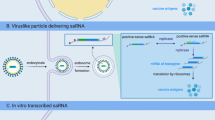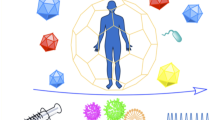Abstract
Defensins display immunostimulatory activities including a chemotactic effect for T lymphocytes/immature dendritic cells and secretion of pro-inflammatory cytokines suggest their role in bridging innate and adaptive immunity. We hypothesized whether defensins with separately emulsified HIV-1 immunogen would elicit peptide-specific systemic and mucosal antibody response in mice. The HIV-1 peptide alone in microsphere showed low peptide-specific antibody response in sera and different washes, while the presence of defensins markedly increased the antibody peak titre both in sera (102,400–409,600) (p < 0.05) and in washes (800–25,600) (p < 0.001). Defensins with HIV-1 peptide were showing 43.0–83.2 % and 38.7–72.3 % in vitro neutralization against laboratory isolates in serum and lavage samples, respectively, higher than HIV-1 peptide alone. Our findings may have implications in the development of new mucosal adjuvant for AIDS vaccination.






Similar content being viewed by others
References
Robinson WE, Tran D, Setsted ME. Anti HIV-1 activity of indolicindin, an antimicrobial peptide from neutrophils. J Leukoc Biol. 1981;63:94–100.
Munk C, Wang W, Cole AM, Hong T, Waring AJ, Lehrer RI. The θ-defensin, retrocyclin inhibit HIV-1 entry. AIDS Res Hum Retrovir. 2003;19:875–81.
Wang W, Cole AM, Hong T, Waring AJ, Lehrer RI. Reterocyclin, an anti retroviral θ-defensin, is a lectin. J Immunol. 2003;170:4708–16.
Zhang L, Yu J, Lopez P, Fu S, Zhang W, Ho DD. Contribution of human α-defensin-1, 2 and 3 to the anti HIV-1 activity of CD8 antiviral factor. Science. 2002;298:995–9.
Huang L, Proske RJ, McDermott AM. Functional roles of the epithelial-derived antimicrobial-derived peptide LL-37 at the ocular surface. Invest Ophthalmol Vis Sci. 2004;45: ARVO E-abstr 4940.
Koczulla AR, Bals R. Antimicrobial peptides: current status and therapeutic potential. Drugs. 2003;63:389–406.
Yang D, Biragyn A, Hoover DM, Lubkowski J, Oppenheim JJ. Multiple roles of antimicrobial defensins, cathelicidins, and eosinophil-derived neurotoxin in host defense. Annu Rev Immunol. 2004;22:181–215.
Yang D, Biragyn A, Kwak LW, Oppenheim JJ. Mammalian defensins in immunity: more than just microbicidal. Trends Immunol. 2002;23:291–6.
Lehrer RI, Ganz T. Defensins of vertebrate animals. Curr Opin Immunol. 2002;14:96–102.
Aggarwal L, Haq W, Hanson CV, Rao DN. Generating neutralizing antibodies Th1 response and MHC nonrestricted immunogenicity of HIV-1 env and gag peptides in liposomes and ISCOMs with inbuilt adjuvanticity. J Immune Based Ther Vaccine. 2003;1:5–37.
Gokulan K, Khare S, Rao DN. Increase in the immunogenicity of HIV peptides antigens by chemical linkage of polytufsin (TKPR) 40 into their sequence. Cell Biol. 1999;18:623–6.
Gokulan K, Rao DN. Bioactive fragment of human IL-1β (163–171) modulates response to synthetic peptides of HIV. Microbiol Immunol. 1997;41:965–74.
Pun PB, Bhat AA, Mohan T, Kulkarni S, Paranjape R, Rao DN. Intranasal administration of peptide antigens of HIV with mucosal adjuvant CpG ODN coentrapped in microparticles enhances the mucosal and systemic immune responses. Int Immunopharmacol. 2009;9:468–77.
Manocha M, Pal PC, Chitralekha KT, et al. Enhanced mucosal and systemic immune response with intranasal immunization of mice with HIV peptides entrapped in PLGA microparticles in combination with Ulex Europaeus-I lectin as M cell target. Vaccine. 2005;23:5599–617.
Mohan T, Sharma C, Bhat AA, Rao DN. Modulation of HIV peptide antigen specific cellular immune response by synthetic α- and β-defensin peptides. Vaccine. 2013 Feb 2. doi:10.1016/j.vaccine.2013.01.041. [Epub ahead of print] PubMed PMID: 23384751.
Ann JH, Eva GR, David MT, et al. Broadly neutralizing monoclonal antibodies 2F5 and 4E10 directed against the human immunodeficiency virus type 1 gp41 membrane-proximal external region protect against mucosal challenge by Simian-Human immunodeficiency virus SHIVBa-L. J Virol. 2010;84:1302–13.
Sherry MO, Donna LR, Wei W, Alexander MC, Alan JW, Renu BL, Robert IL. RC-101, a retrocyclin-1 analogue with enhanced activity against primary HIV type 1 isolates. AIDS Res Hum Retroviruses. 2004;20:1157–65.
Raj PA, Antonyraj KJ, Karunakaran T. Large-scale synthesis and functional elements for the antimicrobial activity of defensins. Biochem J. 2000;347:633–41.
Patrick B, O’Donnell, James WM. Preparation of microspheres by the solvent evaporation technique. Adv Drug Deliv Rev. 1997;28:25–42.
Smith PK, Krohn RI, Hermanson GT, Mallia AK, Gartner FH, Provenzano MD. Measurement of protein using bicinchoninic acid. Anal Biochem. 1985;150:76–85.
Tripathi V, Chitralekha KT, Bakshi AR, Tomar D, Deshmukh RA, Baig MA, Rao DN. Inducing systemic and mucosal immune responses to B-T construct of F1 antigen of Yersinia pestis in microsphere delivery. Vaccine. 2006;24:3279–89.
Thakar MR, Kumar BK, Mhahjan BA, Mehendale SM, Paranjape RS. Extensive cross-reactive neutralizing antibody response in Indian patients with limited genetic diversity of HIV. Virology. 2007;359:295–301.
Vajdy M, Singh M. Intranasal delivery of vaccines against HIV. Expert Opin Drug Deliv. 2006;3:247–59.
Belyakov IM, Wyatt LS, Ahlers JD, et al. Induction of a mucosal cytotoxic T-lymphocyte response by intrarectal immunization with a replication-deficient recombinant vaccinia virus expressing human immunodeficiency virus 89.6 envelope protein. J Virol. 1998;72:8264–72.
Stevceva L, Alvarez X, Lackner AA, et al. Both mucosal and systemic routes of immunization with the live, attenuated NYVAC/simian immunodeficiency virus SIV(gpe) recombinant vaccine result in gag-specific CD8 + T-cell responses in mucosal tissues of macaques. J Virol. 2002;76:11659–76.
Zhou Q, Hidajat R, Peng B, et al. Comparative evaluation of oral and intranasal priming with replication-competent adenovirus 5 host range mutant (Ad5hr)-simian immunodeficiency virus (SIV) recombinant vaccines on immunogenicity and protective efficacy against SIV(mac251). Vaccine. 2007;25:8021–35.
Cafaro A, Macchia I, Maggiorella MT, et al. Innovative approaches to develop prophylactic and therapeutic vaccines against HIV/AIDS. Adv Exp Med Biol. 2009;655:189–242.
Cortes-Perez NG, Lefevre F, Corthier G, Adel-Patient K, Langella P, Bermudez-Humaran LG. Influence of the route of immunization and the nature of the bacterial vector on immunogenicity of mucosal vaccines based on lactic acid bacteria. Vaccine. 2007;25:6581–8.
David WM, Stacey LS, Rebecca MR, Timothy NJB, Yang XF, Engelhard VH. Route of immunization with peptide-pulsed dendritic cells controls the distribution of memory and effector T cells in lymphoid tissues and determines the pattern of regional tumor control. J Exp Med. 2003;198:1023–34.
Fukuyama S, Nagatake T, Kim DY, et al. Cutting edge: uniqueness of lymphoid chemokine requirement for the initiation and maturation of nasopharynx-associated lymphoid tissue organogenesis. J Immunol. 2006;177:4276–80.
Kiyono H, Fukuyama S. NALT- versus Peyer’s-patch-mediated mucosal immunity. Nat Rev Immunol. 2004;4:699–710.
Kantele A, Hakkinen M, Moldoveanu Z, Lu A, Savilahti E, Alvarez RD, Michalek S, Mestecky J. Differences in immune responses induced by oral and rectal immunizations with Salmonella typhi Ty21a: evidence for compartmentalization within the common mucosal immune system in humans. Infect Immun. 1998;66:5630–5.
Kozlowski PA, Cu-Uvin S, Neutra MR, Flanigan TP. Comparison of the oral, rectal, and vaginal immunization routes for induction of antibodies in rectal and genital tract secretions of women. Infect Immun. 1997;65:1387–94.
Kozlowski PA, Selvi BW, Rebecca ML, Timothy PF, Rosalyn RP, Susan CU, Marian RN. Differential induction of mucosal and systemic antibody responses in women after nasal, rectal, or vaginal immunization: influence of the menstrual cycle. J Immunol. 2002;169:566–74.
Imaoka K, Miller CJ, Kubota M, et al. Nasal immunization of nonhuman primates with simian immunodeficiency virus p55gag and cholera toxin adjuvant induces Th1/Th2 help for virus-specific immune responses in reproductive tissues. J Immunol. 1998;161:5952–8.
Staats HF, Montgomery SP, Palker TJ. Intranasal immunization is superior to vaginal, gastric, or rectal immunization for the induction of systemic and mucosal anti-HIV antibody responses. AIDS Res Hum Retroviruses. 1997;13:945–52.
Gallichan WS, Rosenthal KL. Effects of the estrous cycle on local humoral immune responses and protection of intranasally immunized female mice against herpes simplex virus type 2 infection in the genital tract. Virology. 1996;224:487–97.
Wu HY, Abdu S, Stinson D, Russell MW. Generation of female genital tract antibody responses by local or central (common) mucosal immunization. Infect Immun. 2000;68:5539–45.
Brannon-Peppas L. Recent advances on the use of biodegradable microparticles and nanoparticles in controlled drug delivery. Int J Pharmaceut. 1995;116:1–9.
Beck LR, Cowsar DR, Lewis DH, et al. A new long-acting injectable microcapsule system for the administration of progesterone. Fertil Steril. 1979;31:545–51.
Offit PA, Khoury CA, Moser CA, Clark HF, Kim JE, Speaker TJ. Enhancement of rotavirus immunogenicity by microencapsulation. Virology. 1994;203:134–43.
Jenkins PG, Coombes AG, Yeh MK, Thomas NW, Davis SS. Aspects of the design and delivery of microparticles for vaccine applications. J Drug Target. 1995;3:79–81.
Gutierro I, Hernandez RM, Igartua M, Gascon AR, Pedraz JL. Size dependent immune response after subcutaneous, oral and intranasal administration of BSA loaded nanospheres. Vaccine. 2002;21:67–77.
Raghuvanshi RJ, Mishra A, Talwar GP, Levy PJ, Labhasetwar V. Enhanced immune response with a combination of alum and biodegradable nanoparticles containing tetanus toxoid. J Microencap. 2001;18:723–32.
Fahy RJ, Diaz PT, Hart J, Wewers MD. BAL and serum IgG levels in healthy asymptomatic HIV- infected patients. Chest. 2001;119:196–203.
Curtis PB, Gregory DS, Liao HX, Haynes BF, Staats HF. Cytokines as adjuvants for the induction of anti-human immunodeficiency virus peptide immunoglobulin G (IgG) and IgA antibodies in serum and mucosal secretions after nasal immunization. J Virol. 2002;76:517–24.
Sollid LM, Kvale D, Brandzaeg P, Markussen G, Thornsby E. Interferon-γ enhances expression of secretory component, the epithelial receptor for polymeric immunoglobulins. J Immunol. 1987;138:4303–6.
Gerburg MS, Patricia WF, Ward ES, Dumont J, Dickinson BL, Blumberg RS, Wayne I. Receptor-mediated immunoglobulin G transport across mucosal barriers in adult life: functional expression of FcRn in the mammalian lung. J Exp Med. 2002;196:303–10.
Tani K, Murphy WJ, Chertov O, Oppenheim JJ, Wang JM. The neutrophil granule protein cathepsin G activates murine T lymphocytes and upregulates antigen-specific Ig production in mice. Biochem Biophys Res Commun. 2001;282:971–6.
Oppenheim JJ, Biragyn A, Kwak LW, Yang D. Roles of antimicrobial peptides such as defensins in innate and adaptive immunity. Ann Rheum Dis. 2003;62(Suppl 2):ii17–ii21.
Tani K, Murphy WJ, Chertov O, Salcedo R, Koh CY. Defensins act as potent adjuvant that promote cellular and humoral immune responses in mice to a lymphoma idiotype and carrier antigen. Int Immunol. 2000;12:691–700.
Lillard JW, Prosper NB, Chertov O, Joost JO, McGhee JR. Mechanisms for induction of acquired host immunity by neutrophil peptide defensins. PNAS. 1999;96:651–6.
Kulkarni S, Tripathy S, Gangakhedkar R, Jadhav S, Agnihotri K, Sane S, Bollinger R, Paranjape R. Neutralizing antibody responses in recent seroconverters with HIV-1 subtype C infections in India. AIDS Res Hum Ret. 2008;24:1159–66.
Acknowledgments
The authors wish to acknowledge ICMR-DBT, Govt. of India for providing financial assistance and carry out the work. Dr. Teena Mohan is thankful to UGC, Govt. of India to provide junior/senior research scholarships.
Conflict of interest
None.
Author information
Authors and Affiliations
Corresponding author
Rights and permissions
About this article
Cite this article
Mohan, T., Mitra, D. & Rao, D.N. Nasal delivery of PLG microparticle encapsulated defensin peptides adjuvanted gp41 antigen confers strong and long-lasting immunoprotective response against HIV-1. Immunol Res 58, 139–153 (2014). https://doi.org/10.1007/s12026-013-8428-5
Published:
Issue Date:
DOI: https://doi.org/10.1007/s12026-013-8428-5




